ISSN ONLINE(2278-8875) PRINT (2320-3765)
ISSN ONLINE(2278-8875) PRINT (2320-3765)
M.L.N.Kiran Kumar1 and T.Rama Sastry2
|
| Related article at Pubmed, Scholar Google |
Visit for more related articles at International Journal of Advanced Research in Electrical, Electronics and Instrumentation Engineering
The Model Reference Adaptive System (MRAS) is one of the major approaches for adaptive control. Among various types of adaptive system configurations, MRAS is important since it is relatively easy to implement systems with high speed of adaptation for a wide range of applications. In this paper, Development of Model Reference Adaptive Technique with fuzzy controller and study of the performance of Model Reference Adaptive System (MRAS) with pid controller is simulated under MATLAB/Simulink environment, and applying it to the Induction motor model as sensorless speed control method.
Keywords |
| Sensorless Induction Motor, Fuzzy PID Controller, Model Reference Adaptive System (MRAS) |
INTRODUCTION |
| Induction motor (IM) can be considered as the ‘workhorse’ of the industry because of its special features such as low cost, high reliability, low inertia, simplicity and ruggedness. Even today IMs especially the squirrel cage type, are widely used for single speed applications rather than variable speed applications due to the complexity of controlling algorithm and higher production cost of IM variable speed drives. However, there is a great interest on variable speed operation of IM within the research community mainly because IMs can be considered as a major industrial load of a power system. On the other hand the IMs consume a considerable amount of electricity generated. The majority of IMs are operated at constant speed, determined by the pole pair number and the stator supply frequency. The two names for the same type of motor, induction motor and asynchronous motor, describe the two characteristics in which this type of motor differs from DC motors and synchronous motors. Induction refers to the fact that the field in the rotor is induced by the stator currents, and asynchronous refers to the fact that the rotor speed is not equal to the stator frequency. No sliding contacts and permanent magnets are needed to make an IM work, which makes it very simple and cheap to manufacture. As motors, they rugged and require very little maintenance. However, their speeds are not as easily controlled as with DC motors. They draw large starting currents, and operate with a poor lagging factor when lightly loaded. |
MODELLING OF INDUCTION MOTOR |
| The The control and speed sensorless estimation of IM drives is a vast subject. Traditionally, the IM has been used with constant frequency sources and normally the squirrel-cage machine is utilized in many industrial applications, A typical construction of a squirrel cage IM is illustrated in Figure 1. Its main advantages are the mechanical and electrical simplicity and ruggedness, the lack of rotating contacts (brushes) and its capability to produce torque over the entire speed range. |
| Before going to analyze any motor or generator it is very much important to obtain the machine in terms of its equivalent mathematical equations. Traditional per phase equivalent circuit has been widely used in steady state analysis and design of induction motor, but it is not appreciated to predict the dynamic performance of the motor. The dynamics consider the instantaneous effects of varying voltage/currents, stator frequency, and torque disturbance. The dynamic model of the induction motor is derived by using a two-phase motor in direct and quadrature axes. This approach is desirable because of the conceptual simplicity obtained with two sets of windings, one on the stator and the other in the rotor. The equivalence between the three phase and two phase machine models is derived from simple observation, and this approach is suitable for extending it to model an n-phase machine by means of a two phase machine. |
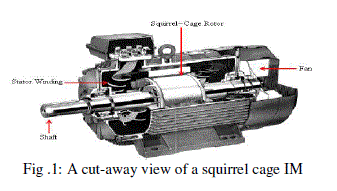 |
| 2.1 REFERENCE FRAMES |
| The required transformation in voltages, currents, or flux linkages is derived in a generalized way. The reference frames are chosen to be arbitrary and particular cases, such as stationary, rotor and synchronous reference frames are simple instances of the general case. R.H. Park, in the 1920s, proposed a new theory of electrical machine analysis to represent the machine in d – q model. He transformed the stator variables to a synchronously rotating reference frame fixed in the rotor, which is called Park’s transformation. He showed that all the time varying inductances that occur due to an electric circuit in relative motion and electric circuits with varying magnetic reluctances could be eliminated. |
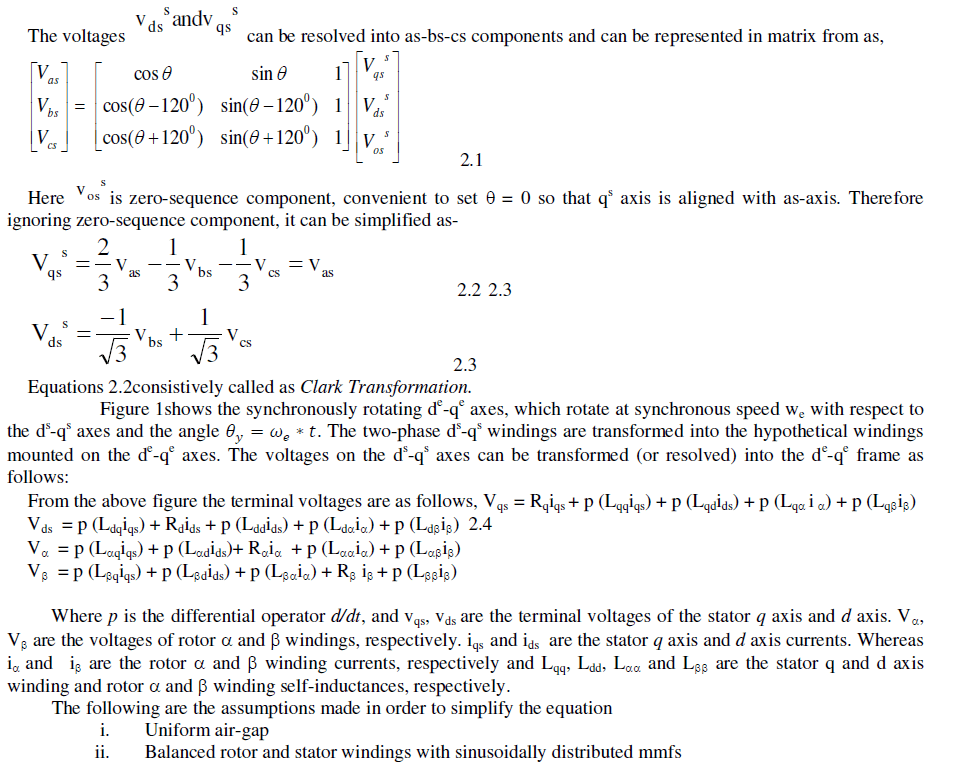 |
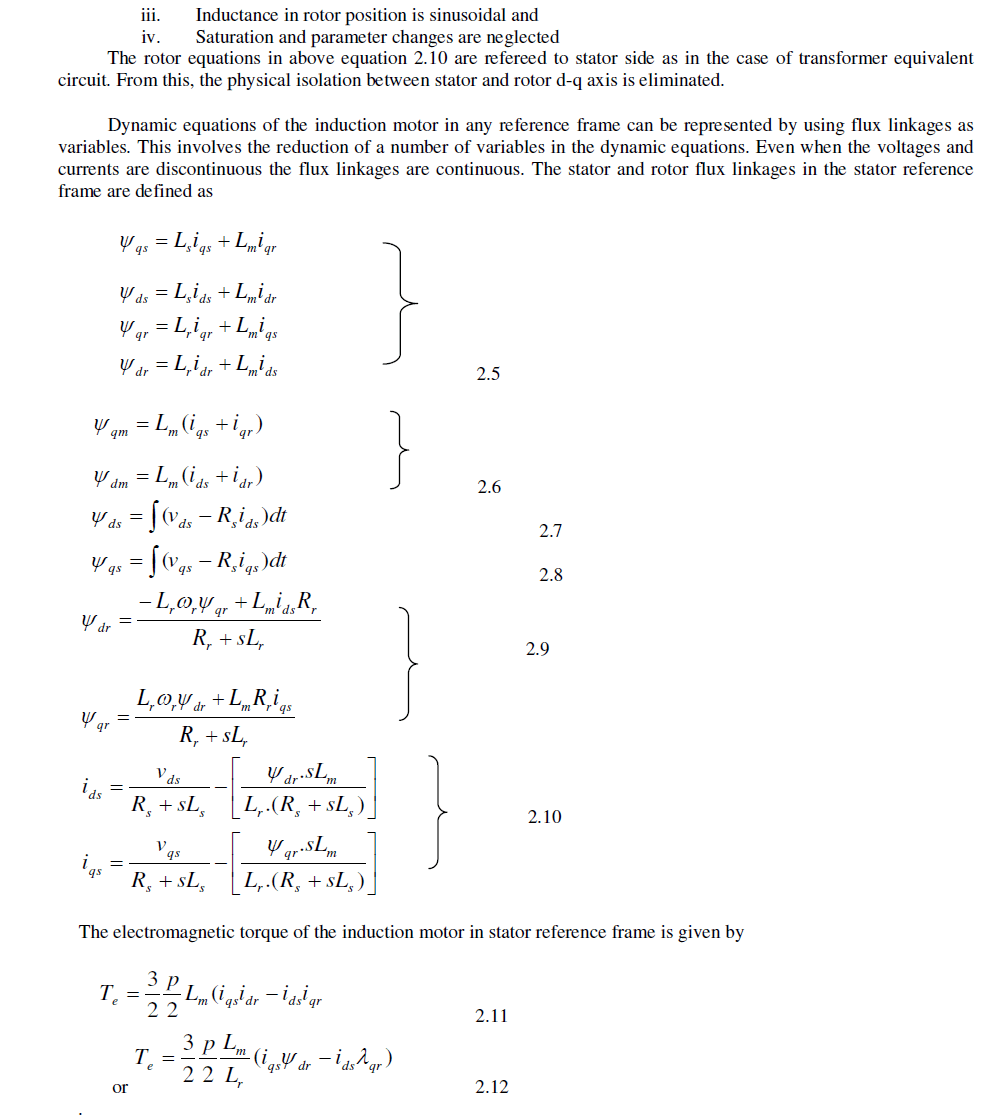 |
MODELLING OF SRM |
| The fundamentals of vector control can be explained with the help of figure 2, where the machine model is represented in a synchronously rotating reference frame. |
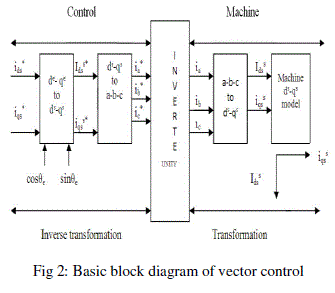 |
| 3.1 INVERTER |
| Processing of the torque status output and the flux status output is handled by the optimal switching logic. The function of the optimal switching logic is to select the appropriate stator voltage vector that will satisfy both the torque status output and the flux status output. |
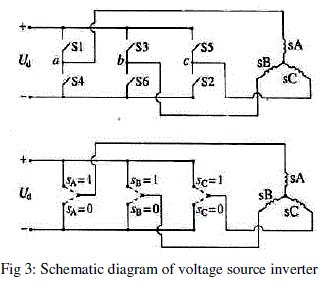 |
| 3.2 BASIC THEORY |
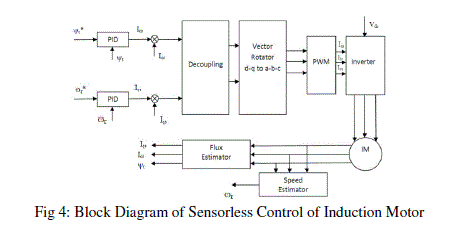 |
MODEL REFERENCING ADAPTIVE SYSTEM (MRAS) |
| Tamai [5] has proposed one speed estimation technique based on the Model Reference Adaptive System (MRAS) in 1987. Two years later, Schauder [6] presented an alternative MRAS scheme which is less complex and more effective. The MRAS approach uses two models. The model that does not involve the quantity to be estimated (the rotor speed, ωr) is considered as the reference model. The model that has the quantity to be estimated involved is considered as the adaptive model (or adjustable model). |
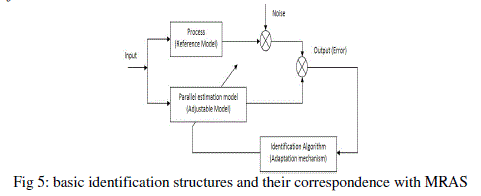 |
4.1 FUZZY CONTROLLER DESIGN |
| The main use of fuzzy control system is based on empirical rules is more effective. Fuzzy systems are easily upgraded by adding new rules or new features to improve performance. Fuzzy control can be used to improve existing traditional control systems by adding a layer of intelligence to the current control method [7]. The fuzzy logic controller consists of Fuzzy Inference System Editor. The output of the controller is crisp value. This Graphical User Interface consists of FIS Editor, Membership function Editor, Rule Editor, Rule Viewer and Surface Viewer |
4.2 MAMDANI-TYPE INFERENCE METHOD |
| Mamdani’s fuzzy inference method is the most commonly seen fuzzy methodology. Mamdani’s method was among the first control systems built using fuzzy set theory. Mamdani-type inference, as we have defined it for the Fuzzy Logic Toolbox, expects the output membership functions to be fuzzy sets. After the aggregation process, there is a fuzzy set for each output variable that needs defuzzification. It’s possible, and in many cases much more efficient, to use a single spike as the output membership functions rather than a distributed fuzzy set. This is sometimes known as a singleton output membership function, and it can be thought of as a pre-defuzzified fuzzy set. It enhances the efficiency of the defuzzification process because it greatly simplifies the computation required by the more general Mamdani method, which finds the centroid of a two-dimensional function. The flow proceeds up from the inputs in the lower left, then across each row, or rule, and then down the rule outputs to finish in the lower right. This is a very compact way of showing everything at once, from linguistic variable fuzzification all the way through defuzzification of the aggregate output. |
| Fuzzy logic controllers usually outperform other controllers in complex, nonlinear, or undefined systems for which a good practical knowledge exists. Fuzzy logic controllers are based on fuzzy sets, i.e., classes of objects in which the transition from membership to non membership is smooth rather than abrupt. Therefore, boundaries of fuzzy sets can be vague and ambiguous, making them useful for approximation systems. |
| There are five primary GUI tools for building, editing [3, 7], and observing fuzzy inference systems in the Fuzzy Logic Toolbox: the Fuzzy Inference System or FIS Editor, the Membership Function Editor, the Rule Editor, the Rule Viewer, the Surface Viewer.The FIS Editor handles the high-level issues for the system: The Fuzzy Logic Toolbox doesn’t limit the number of inputs. However, the number of inputs may be limited by the available memory of the machine. If the number of inputs is too large, or the number of membership functions is too big, then it may also be difficult to analyze the FIS using the other GUI tools. |
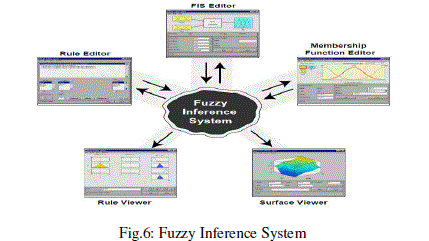 |
4.3 MEMBERSHIP FUNCTIONS |
| A membership function (MF) is a curve that defines how each point in the input space is mapped to a membership value (or degree of membership) between 0 and 1. The input space is sometimes referred to as the universe of discourse, a fancy name for a simple concept. The Fuzzy Logic Toolbox includes 11 built-in membership function types. |
| The simplest membership functions are formed using straight lines. Of these, the simplest is the Triangular membership function, and it has the function name trimf. It’s nothing more than a collection of three points forming a triangle. The Trapezoidal membership function, trapmf, has a flat top and really is just a truncated triangle curve. These straight line membership functions have the advantage of simplicity. |
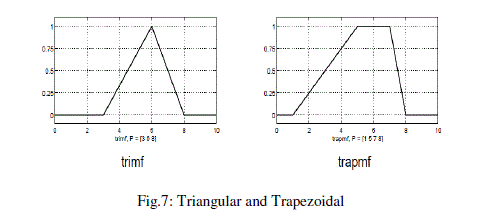 |
4.4 FUZZY LOGIC CONTROLLER WITH RULE VIEWER |
| The Fuzzy Logic Toolbox library contains the Fuzzy Logic Controller and Fuzzy Logic Controller with Rule Viewer blocks. It also includes a Membership Functions sublibrary that contains Simulink blocks for the built-in membership functions. |
VECTOR CONTROL OF INDUCTION MOTOR |
| The The Vector Control or Field orientation control of induction motor is simulated on MATLAB ® /SIMULINK - platform to study the various aspects of the controller. The actual system can be modeled with a high degree of accuracy in this package.. This chapter discusses the realization of vector control of induction motor using Simulink blocks. |
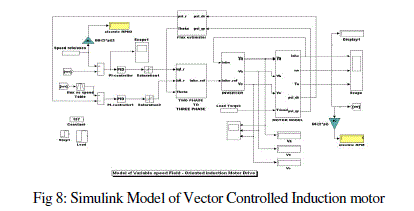 |
INDUCTION MOTOR MODEL |
| The motor is modeled in stator reference frame. The dynamic equations are given using these equations we can develop the induction motor model in stator reference frame. Fig 9 shows the simulink block diagram for motor model. Inputs to this block are direct and quadrature axes voltages and load torque. The outputs are direct and quadrate axis rotor fluxes, direct and quadrature axes stator currents, electrical torque developed and rotor speed. |
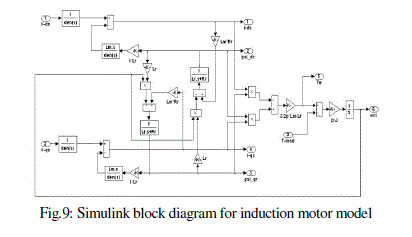 |
INVERTER |
| The function of the optimal switching logic is to select the appropriate stator voltage vector that will satisfy both the torque status output and the flux status output. Processing of the torque status output and the flux status output is handled by the optimal switching logic. |
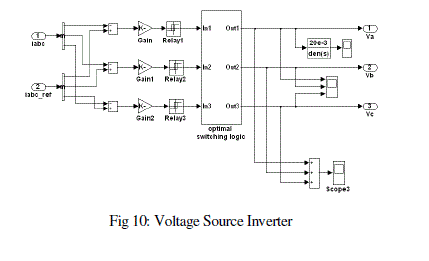 |
SENSORLESS CONTROL OF INDUCTION MOTOR |
| The Sensorless control of induction motor using Model Reference Adaptive System (MRAS) is simulated on MATLAB/SIMULINK - platform to study the various aspects of the controller.. Here we are going to discuss the realization of Sensorless control of induction motor using MRAS for simulink blocks.. Main subsystems are the 3-phase to 2-phase transformation, 2-phase to 3-phase transformation, induction motor model, Model Reference Adaptive System (MRAS) and optimal switching logic & inverter. |
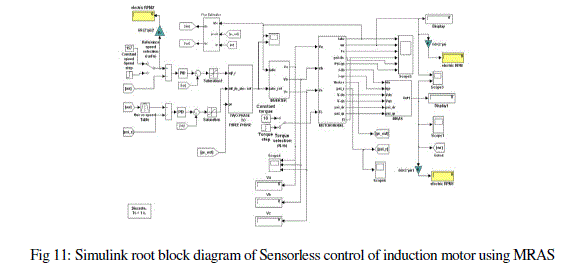 |
MODEL REFERNCE ADAPTIVE SYSTEM (MRAS) |
| Figure 15 shows the simulink block diagram Model Referencing Adaptive System (MRAS). Which is consists Two blocks one is called Reference Model and other is Adaptive Model. The voltage model’s stator-side equations, are defined as a Reference Model and the simulink block diagram of Reference Model is shown in Fig 11. The Adaptive Model receives the machine stator voltage and current signals and calculates the rotor flux vector signals, as indicated by equations, which is shown in Fig 12. By using suitable adaptive mechanism the speed ïÃÂ÷r, can be estimated and taken as feedback. |
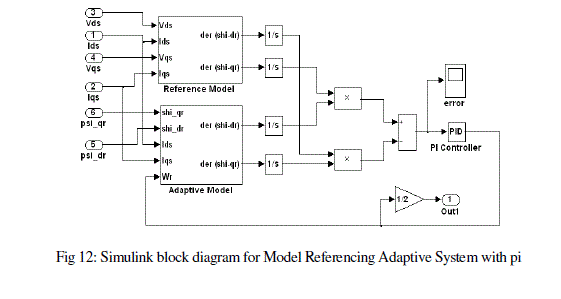 |
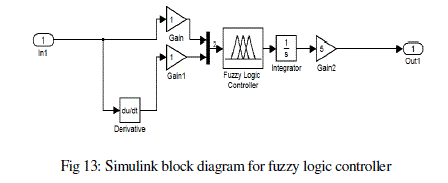 |
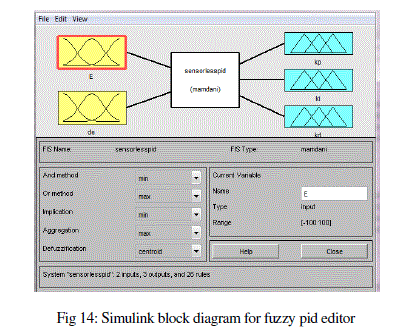 |
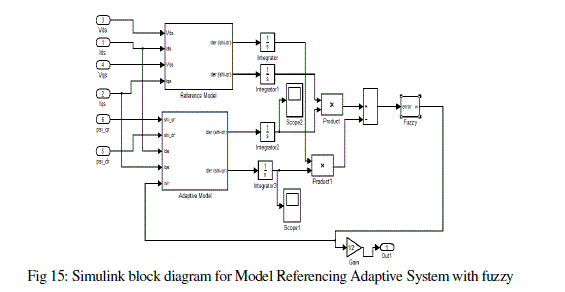 |
MATLAB BASED MODELING AND PERFORMANCE |
| The simulation of Vector Control of Induction Motor is done by using MATLAB ® /SIMULINK. The results for different cases are given below. |
| Reference speed = 100 rad/sec |
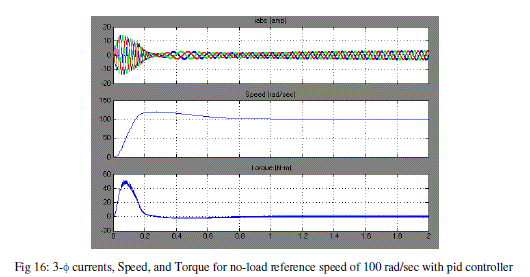 |
| Fig. 16 shows the no load line currents, speed and torque wave forms with pid. It can be seen that at starting the values of currents and torque will be high. The motor reaches to its final steady state position with in less time and rise time is 0.15sec. Hence it has fast dynamic response. |
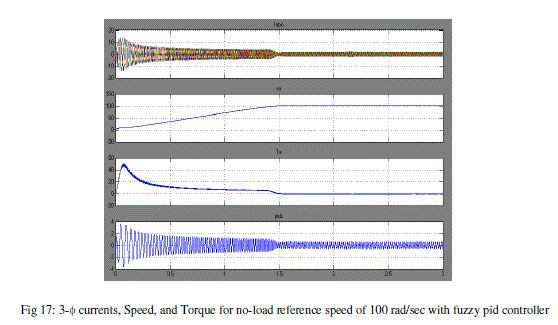 |
| Fig. 17 shows the no load line currents, speed and torque wave forms with fuzzy pid. It can be seen that at starting the values of currents and torque will not fluctuate. The motor reaches to its final steady state position with in less time and rise time is 1.5sec. Hence fuzzy controller can can reduce the peak overshoot. |
CONCLUSION |
| In this paper, Sensorless control of induction motor using Model Reference Adaptive System (MRAS) technique has been proposed. Sensorless control gives the benefits of Vector control without using any shaft encoder. In this paper the principle of vector control and Sensorless control of induction motor is given elaborately. The mathematical model of the drive system has been developed and results have been simulated. Simulation results of Vector Control and Sensorless Control of induction motor using MRAS technique using pid and fuzzy pid controller were carried out by using Matlab/Simulink and from the analysis of the simulation results, the transient and steady state performance of the drive have been presented and analyzed. |
| From the simulation results, it can be observed that, in steady state there are ripples in torque wave and also the starting current is high. |
References |
|